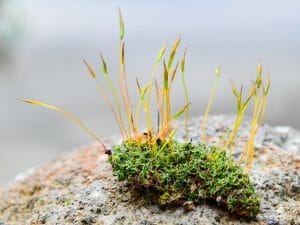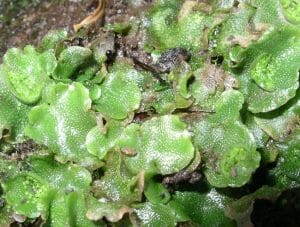Nonvascular Plant Definition
A nonvascular plant is any species of plant which does not have specialized vascular tissues. This includes everything from higher structured forms of green algae, which have plant-like characteristics, to mosses (Bryophyta), liverworts (Marchantiophyta) and hornworts (Anthocerotophyta). Members of these groups, which live in both marine environments and on land, are considered a nonvascular plant.
Lifecycle of a Nonvascular Plant
All plants and some algae exhibit an alternation of generations life cycle. In this cycle, a gametophyte gives rise to gametes. The gametophyte is a haploid organism, containing only one set of DNA. The gametes, therefore, are produced via mitosis. When these gametes fuse, they create a zygote, which is a new diploid organism. This zygote will grow up into the sporophyte generation.
The sporophyte generation is responsible for producing spores. To do this, a mature sporophyte will produce cells capable of undergoing meiosis, a cell division which divides the double set of DNA. The spores, therefore, are again haploid. Spores, unlike gametes, develop directly into new organisms, the gametophyte generation. Thus, each generation alters between a haploid and diploid state.
In nonvascular plants, the sporophyte generation is usually smaller, and dependent on the gametophyte. Mosses, for example, exist almost entirely as gametophytes until the proper conditions arise, in which the sporophyte generation is created. While the gametophytes form a large mat or bundle with cells capable of photosynthesis, the sporophyte consists of a tiny stalk upon which spores are created and released.
This is directly opposite of what vascular plants do. While a nonvascular plant shows a dominant gametophyte generation, vascular plants show a dominant sporophyte generation. While having vascular tissues does help a vascular plant distribute water, vascular plants are not necessarily more successful than a nonvascular plant. Using other evolved techniques, a nonvascular plant can be found in areas which few vascular plants could colonize. Because nonvascular plants do not need to grow roots or have an excess of nutrients, a nonvascular plant is often a pioneer species, colonizing barren soil and providing a basis for other plants to colonize on.
Examples of a Nonvascular Plant
Moss
Moss is a nonvascular plant found worldwide. Moss is often one of the only plant types to colonize certain areas, including areas with poor soil. Moss typically grows in wet, damp areas. This is not always the case. Moss has colonized most environments, from the cold Artic to the dry desert. There are approximately 12,000 species of moss. Some moss species are nearly microscopic, while others can grow over a foot tall. Mosses, being a nonvascular plant, are mostly limited in height beyond this. Peat is a type of fuel created from the dense sheets of Sphagnum moss which grows in peat bogs. Moss can be seen in the image below.
Liverwort
Where moss grows in small branching structures, and many organisms get packed in a larger mat or bundle, liverwort grows as small, individual leaf-like structure. The thallus, as it is called, is the dominant gametophyte. The thallus will produce specialized organs, to house the sporophyte. Liverwort and hornwort are almost indistinguishable, besides some differences in their thallus and the structure of their sporophytes. However, genetic evidence has revealed that liverwort and hornwort, while both a nonvascular plant group, are unrelated enough to deserve two separate divisions. A typical liverwort can be seen below.
Hornwort
Commonly mistaken as liverwort, hornwort is a closely related group of nonvascular plant species. Like mosses and liverworts, hornworts exist as a dominant gametophyte form. Hornworts, because of the way that they combine their chloroplasts with other organelles, are thought to be more closely related to certain species of algae than other land plants. While hornwort, liverwort, and mosses used to all belong to the Bryophyta, the hornworts and liverworts have been given their own divisions. This reflects the finding that the groups are not closely related enough to be considered the same group. In the picture below you can see a hornwort. Note that while it looks like liverwort, you can easily see the horn-like structures. These structures house the sporophyte generation, creating spores.
Algae
Not all algae is considered a nonvascular plant. Typically, only those algae found in the clade Viridiplantae are considered nonvascular plants. However, the evolutionary relationships between algae and land plants are not entirely clear. It is sometimes assumed that nonvascular algae led to nonvascular land plants, which led to vascular land plants. This theory, however, is not necessarily supported by the genetic and paleological evidence. However, some algae do have specific tissues, some of which are even specialized for water transport. An alternate theory supposes that some algae developed into vascular plants, where other algae became the modern nonvascular plant.
Quiz
1. A scientist is trying to grow a nonvascular plant which is 20 feet tall. Why is this unlikely?
A. Sounds reasonable enough!
B. Water pressure
C. A nonvascular plant cannot retain water
2. The following is a list of features of vascular plants. Which of the features is shared by a nonvascular plant?
A. Organized, multicellular structure and the ability to photosynthesize
B. An organized internal system for transporting water
C. Specialized corridors of cells for transporting sugar
3. Is a nonvascular plant species LESS EVOLVED than a vascular plant species?
A. No
B. Yes
C. It depends…
References
- Kaiser, M. J., Attrill, M. J., Jennings, S., Thomas, D. N., Barnes, D. K., Brierley, A. S., & Hiddink, J. G. (2011). Marine Ecology: Processes, Systems, and Impacts. New York: Oxford University Press.
- McMahon, M. J., Kofranek, A. M., & Rubatzky, V. E. (2011). Plant Science: Growth, Development, and Utilization of Cultivated Plants (5th ed.). Boston: Prentince Hall.
- Rubinstein, C. V., Gerrienne, P., de la Puente, G., Astini, R. A., & Steemans, P. (2010). Early Middle Ordovician evidence for land plants in Argentina (eastern Gondwana). New Phytologist, 188(2).
Nonvascular Plant


No comments:
Post a Comment